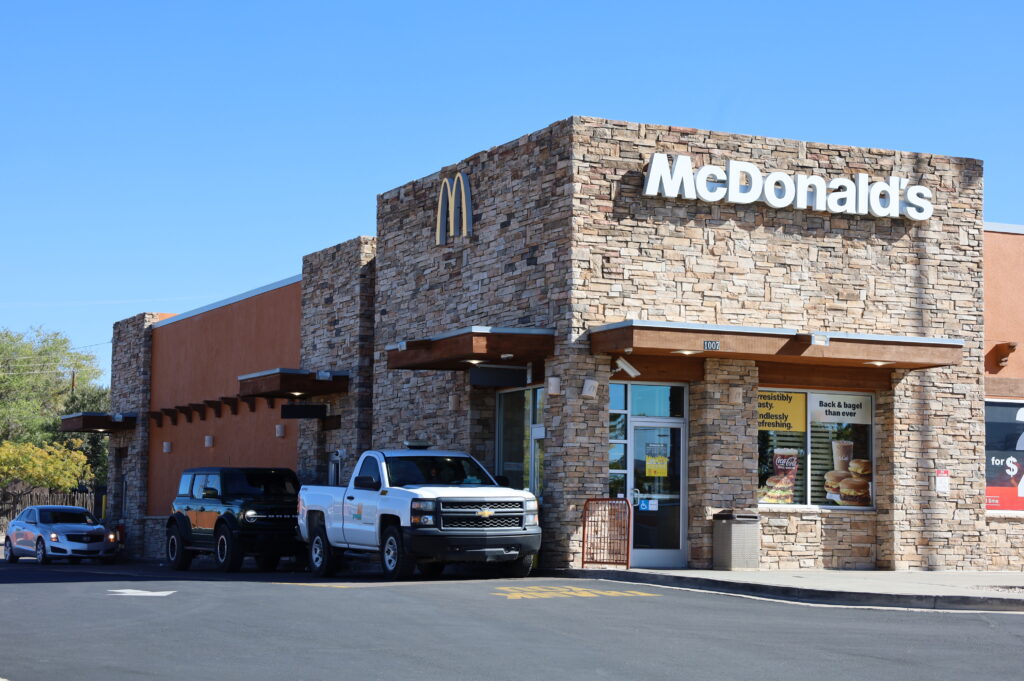Motorists line up at a McDonald’s drive-thru in Santa Fe on Oct. 23, 2024. (Photo by Austin Fisher / Source New Mexico)
New Mexico health officials announced Wednesday they have found at least five cases of E. coli infection stemming from a deadly, multi-state outbreak linked to food from McDonald’s.
At least one person in New Mexico has been hospitalized because of E. coli infection, the state Department of Health said. No one in New Mexico has died.
Everyone infected in this outbreak reported eating at McDonald’s before becoming sick, and most of them reported eating the Quarter Pounder hamburger, according to the federal Centers for Disease Control and Prevention, which is leading the investigation.
The CDC announced the investigation Tuesday and said one person has died from infection.
On Wednesday, the CDC said McDonald’s had removed beef patties and slivered onions from locations in 12 states, including Colorado, Kansas, Utah, Wyoming, and parts of Idaho, Iowa, Missouri, Montana, Nebraska, Nevada, New Mexico and Oklahoma.
All five of the people confirmed to be infected in New Mexico so far are residents of Bernalillo County, the health department said.
However, that doesn’t mean the outbreak is limited to Bernalillo County, said Dr. Chad Smelser, the department’s deputy state epidemiologist.
“We continue to look for other infected patients throughout the state,” Smelser said in an interview.
McDonald’s, the world’s largest fast food chain, on Tuesday included New Mexico on a list of states where it was temporarily pulling the Quarter Pounder from its menu out of “an abundance of caution.”
Nebraska, Colorado mostly affected in multi-state outbreak of E. coli
McDonalds said in a statement Wednesday that it maintains strict food safety standards and protocols and takes its approach to food safety management extremely seriously.
DOH’s Scientific Laboratory Division earlier this week confirmed that the patients’ stool samples are linked to the larger outbreak, Smelser said.
State officials uploaded the information to the CDC on Wednesday afternoon, he said. At the time of writing, New Mexico was not included in the CDC’s total case count.
“We’ve been involved for weeks with other states that were trying to figure out what was going on, and they’re participating in the data collection over the last several weeks to contribute to the national investigation,” Smelser said.
Most of the time, infected people will experience nausea, vomiting, diarrhea, and stomach cramps, Smelser said. These symptoms will usually last longer than a “run-of-the-mill gastrointestinal illness,” he said.
If anyone feels they have eaten potentially contaminated food and they have diarrhea or vomiting lasting longer than is typical for them, and especially if they have a fever or blood in their urine or stool, they should seek medical care, Smelser said.
People with those symptoms should also stay hydrated with plenty of water, he said, because people lose a lot of water when they vomit or have diarrhea.
Most E. coli bacteria are harmless. But the strain New Mexico and other states are investigating, E. coli O157:H7, produces a potent toxin which damages the intestinal wall lining, causing bloody diarrhea, according to Johns Hopkins Medicine.
GET THE MORNING HEADLINES.

